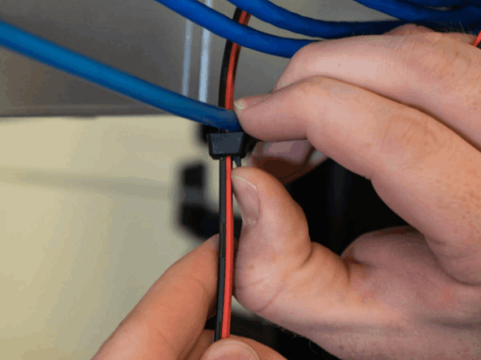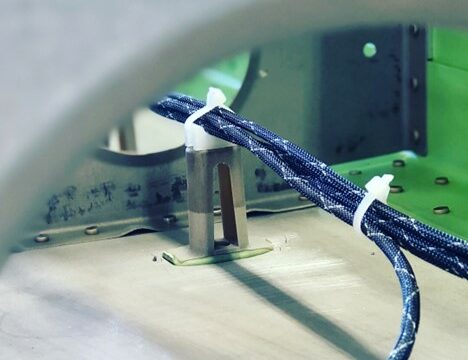The Critical Role of EMI/RFI Shielding For Military Defence

- December 14th, 2023
- Categories: Uncategorised
In the defence and military industries, communication is critical to successful missions, securing equipment, and safety. Military communications are secretive, so precautions must be taken to block attacks on outgoing and incoming communication.
Now more than ever, the military is susceptible to sabotage. Handheld devices, radar jamming, electromagnetic pulse (EMP) attacks, and more drive the need for shielding against EMI and RFI sources that can be harmful. EMI/RFI shielding is essential to protect against civilian networks or foreign military, maintain the privacy of team communications, and allow soldiers to trust the information they receive.
This article will delve into the complexities of EMI/RFI shielding, why defence industries need it, and how it has become a solution.
What is EMI/RFI Shielding?
Electromagnetic interference (EMI) and radio frequency interference (RFI) shielding protects devices and sensitive electronics from potentially harmful external signals, absorbing these interferences through the air.
The military and defence industries use complex devices for secure communications, but they can be hijacked without proper protection. Although EMI and RFI are advantageous as shields, they can equally be used to disrupt the functioning of electronics.
Designers and engineers choose strong materials to maximise the electromagnetic signal strength, placing them around sensitive device areas. Often, reflecting these signals is done using a seal or gasket. As strong as technology can be, it isn’t guaranteed to prevent data loss or disruption.
Types of Electromagnetic Interference
Two types of EMI are typical for the military and the ordinary civilian. However, how are they different?
Narrow-band EMI. This often occurs with radios, TV, and mobile phones as a discrete frequency. If signals cross and a device malfunctions, usually, a user can tune out this disruption without causing any long-term damage.
Broadband EMI. Occupying a more significant part of the electromagnetic spectrum, this type of EMI can cause severe damage to devices and is more detrimental to the defence industries.
What Are EMI Shielding Materials?
Engineers often use metals, conductive plastics, carbon-loaded plastics, conductive coatings, or a metal mesh for EMI shielding, which can be combined for defence industry applications. So, what kind of materials are used to protect against magnetic fields?
Copper alloy 770 / Nickel silver
Also known as alloy 770, nickel silver contains copper, nickel, and zinc and is commonly used for its corrosion resistance. Copper alloy 770 works best for mid-kHz, ranging up to GHz. It is not recommended for use where magnets are present.
Pre-tin plated steel
More cost-effective than other EMI shielding materials, it is beneficial for protecting against lower frequencies in the kHz range. Carbon steel can provide low-frequency shielding properties, protecting the steel from dust and corrosion.
Copper
Unlike copper alloy 770, copper is the most reliable as it reduces electrical and magnetic waves. It is more expensive than other materials but highly effective as an EMI shield.
Aluminium
With high conductivity and strength-to-weight ratio, aluminium is nearly 60% conductive. Corroding faster than other EMI materials, aluminium has higher oxidation properties and is considered weaker. Always speak to a qualified supplier for guidance on what material is best.
EMI Shielding Film and Foil
EMI materials come in many shapes and forms, and shielding tape, film, and foil have their uses. Conductive silicones shield electronics from magnetic and electrical waves as window films.
EMI Shielding Foam
Carbon foam can be used for EMI shielding and is very flexible and functional compared to metallic components. Shielding from 100 MHz to 20 GHz, foam can provide fire protection, lasts longer than metal, weighs less, and doesn’t rust.
EMI Shielding Silicone
Silicone cannot conduct electricity, but it becomes a conductive material for EMI shielding if used with silicone. Flexible silicone can be cut to fit and is helpful for satellite communication, aerospace, automotive, and electrical industries. Able to resist heat, cold, sunlight, and water, silicone with nickel-graphite can shield radio frequencies up to 10,000 Hz.
Examples of EMI Shielding
Engineers use EMI shielding materials to increase military, government, and financial security, but what are some common examples, and how can EMI shield protect them? A failed system can be dangerous. These are some of the most common systems vulnerable to EMI and RFI attacks.
Missiles and missile defence
An excellent focus is electronic controls and built-in fail-safe measures developed to the highest EMI standards for military personnel safety. This includes elastomer gaskets and conductive paints, preventing electromagnetic interference from weather and electromagnetism.
Ground Vehicles
Militarised transport, such as tanks, rely on EMI shielding to protect their infrastructure and devices. Engine components, electronic devices, and high-security data must be protected from external threats in volatile environments.
Communication Devices
Much like a smartphone, portable devices in the military need to be shielded from electromagnetic fields that can block communication quality and information transmission. EMI shields can protect from the elements, such as lightning.
Stationary Shelters
Shelters on land are commonly used for mission control hubs or data storage for defence systems. In this case, the entire structure and equipment must be protected from environmental radiation.
Avionics
Avionic systems have internal devices that require EMI shielding, such as flight recorders, flight-control systems, navigation systems, radios, and more. A commercial aircraft also has requirements for internal device shielding against electromagnetic interference.
The Impact of EMI/RFI in Aerospace Defence
With the impact of EMI/RFI disruptions on defence industries that require high security, electronics must be shielded to withstand EMI/RFI attacks. But what are the implications of these interfering signals?
Interference from Radiofrequency Signals
Aerospace defence operations rely on uninterrupted, secure communication. EMIF/RFI can disrupt these radio frequency signals, causing communication breakdowns and malfunctions in real-time, which can be detrimental for aerial missions.
Sensitive data can also be compromised and threaten mission security, and attackers can exploit this vulnerability.
Potential Damage by Unshielded Electronic Devices
Aerospace defence equipment with sensitive electronic devices can be affected by equipment malfunction or failure, increased maintenance costs and replacements, and put personnel at risk.
Solar Flares on Communication Devices
Solar flares emit powerful electromagnetic radiation, causing devices in space and high-altitude aircraft to malfunction. This can result in satellite disruption, make navigation challenging by interfering with GPS signals, and pose a radiation hazard to astronauts. Aerospace defence agencies monitor space weather conditions, with contingency plans in place during EMI interferences.
Want to know more about defence industry materials and their uses? Have a look at the importance of ERG materials in advancing aerospace technology.
Considerations When Selection EMI/RFI Shielding

When choosing EMI/RMI shielding as a solution, there are things to remember to ensure they function correctly. Selecting the proper shielding can stop a dangerous encounter with frequency jamming.
Frequency range
What frequency range is your device most vulnerable to? Shielding materials are designed to be effective within specific frequency bands, so you must match the shielding to the frequency standard you’re looking for.
Environmental conditions
Consider the environment where you’ll be using your equipment. Shielding materials must withstand temperature fluctuations, humidity, and other environmental factors. For challenging environments, choose corrosion-resistant materials, such as copper.
Form and design
What form and design are you looking for? Depending on your EMI/RFI needs, you may need a gasket, conductive coatings, enclosures, or adhesives. Space constraints and installation difficulty will influence the form you decide on.
Shielding effectiveness
Always assess the shielding effectiveness of the material. Measured in dB, this indicates how well the shield can block electromagnetic radiation, so consider whether you want a high, low, or medium shielding effectiveness based on the application.
Materials and plating
Based on the type of interference you need protection against, the materials you decide on will alter its effectiveness. The most common materials include copper, aluminium, nickel, and conductive fabrics and coatings such as silicone.
Compatibility
Are your materials compatible with other components? Incompatible materials can reduce the effectiveness of your EMI/RFI shield, producing unwanted effects.
Testing and validation
Testing and validation must be in place to guarantee that all materials and components meet performance outcomes. Specialised testing equipment can detect radiated or conducted emissions and susceptibility.
EMI/RFI Shielding FAQs
What is the difference between EMI and RFI?
All RFI is EMI, but not all EMI is RFI. The difference is the frequency of the signal that is interfering. All frequencies that can cause disruptions are EMI, but RFI only applies to radio transmission frequencies. This can range up to 30 megahertz.
What kind of materials act as EMI/RFI shields?
Many materials can be used as shields if they disrupt an electromagnetic signal. Still, the most common material is metal, ranging from silver, silver nickel, silver aluminium, silver copper, and nickel graphite. Gasket materials can reflect or absorb signals using a filler inside a base material, often made from silicone or fluoro-silicone.
How does shielding from EMI and RFI protect electronic devices?
Able to block electromagnetic signals before they reach devices, EMI/RFI shielding can stop minor crackling in telecommunications and malfunctions in aircraft equipment. Electromagnetic signals have the potential to erase and damage data, and even space satellites aren’t immune and need to be shielded.
What are some familiar sources of EMI/RFI?
Human-caused EMI/RFI can come from devices such as phones, cell networks, computer circuits, power lines, ignitions, etc. Natural disruptive signals such as lightning, solar flares, and auroras also exist.
What industries use EMI/RFI shielding for security?
Any industry that uses electronic devices can benefit from EMI/RFI shielding. Industries heavily relying on this protection include military and defence, aerospace, satellites and telecommunications, medical technology, electric vehicles, and mass transit.
Applied Fasteners and Tooling in Melbourne
At Applied Fasteners and Tooling, we understand the importance of safety and security standards in defence industries such as the military. Markets such as military and defence require supportive fasteners and tooling such as MS Fasteners, Grip Lock Ties, and Click Bond Fasteners , EMI/RFI Shielding for the land, sea, and air. Our comprehension of these critical applications means that your assets will always be ready on short notice.
With services such as application engineering support, product testing, product development and training, program management, and maintenance, contact us today to protect your systems from electromagnetic frequencies.






